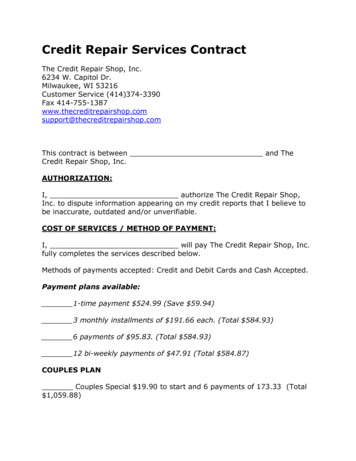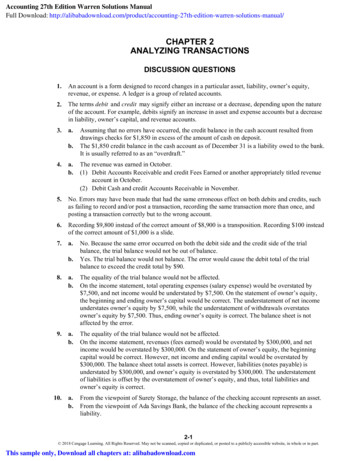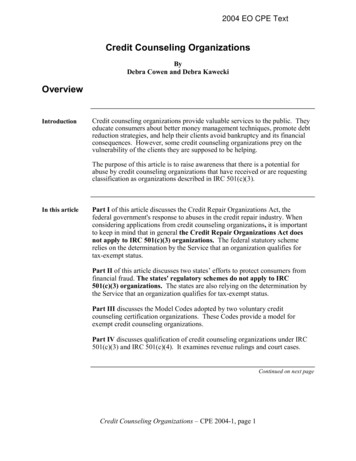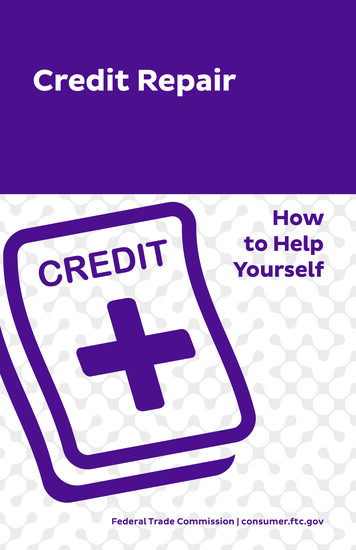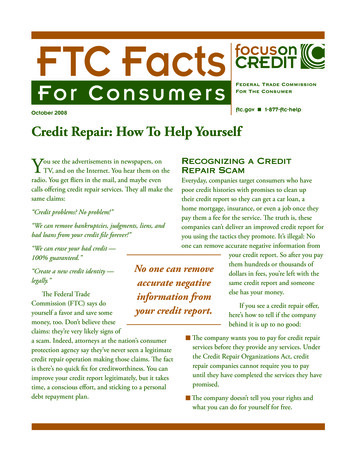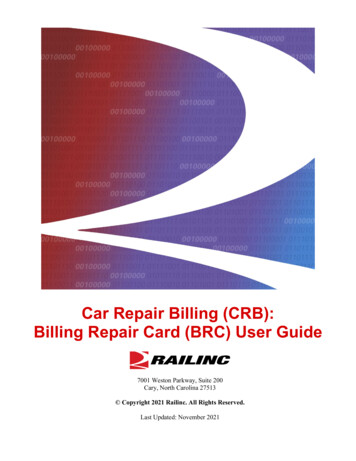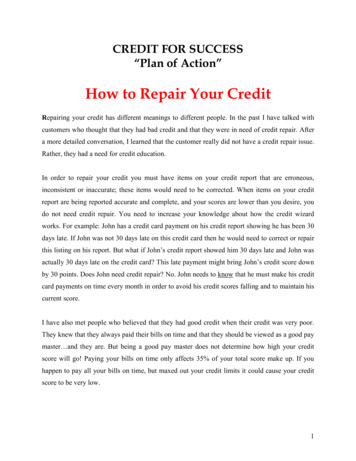
Transcription
CREDIT FOR SUCCESS“Plan of Action”How to Repair Your CreditRepairing your credit has different meanings to different people. In the past I have talked withcustomers who thought that they had bad credit and that they were in need of credit repair. Aftera more detailed conversation, I learned that the customer really did not have a credit repair issue.Rather, they had a need for credit education.In order to repair your credit you must have items on your credit report that are erroneous,inconsistent or inaccurate; these items would need to be corrected. When items on your creditreport are being reported accurate and complete, and your scores are lower than you desire, youdo not need credit repair. You need to increase your knowledge about how the credit wizardworks. For example: John has a credit card payment on his credit report showing he has been 30days late. If John was not 30 days late on this credit card then he would need to correct or repairthis listing on his report. But what if John’s credit report showed him 30 days late and John wasactually 30 days late on the credit card? This late payment might bring John’s credit score downby 30 points. Does John need credit repair? No. John needs to know that he must make his creditcard payments on time every month in order to avoid his credit scores falling and to maintain hiscurrent score.I have also met people who believed that they had good credit when their credit was very poor.They knew that they always paid their bills on time and that they should be viewed as a good paymaster and they are. But being a good pay master does not determine how high your creditscore will go! Paying your bills on time only affects 35% of your total score make up. If youhappen to pay all your bills on time, but maxed out your credit limits it could cause your creditscore to be very low.1
The credit wizard can be a complex system if you do not understand how the System works.Once you become educated about the System it is as easy as 1 1 2. Learn and follow theformula and you will get the desired results every time.The process to repairing your credit is relatively simple, but you must be patient and persistent inorder to succeed. Don’t give up! You must spend time learning what to do and what not to do asit relates to the credit wizard. Know the triggers that increase or decrease your scores. Never takean action based on what you hear from a friends and relatives who are not credit experts.Remember, you do not need a credit repair company, an attorney or a credit professional torepair your credit. These services can be quite costly over time and chances are you will needthem more than once. You SHOULD seek the advice or counsel of credit professionals andattorneys but only to learn the intricate details on how to repair your own credit. I highlyrecommend that you give ample time and studying to the Credit Repair System before you beginthe credit repair process on your own, especially if you do not have a personal credit coach.How to read a Credit ReportThe first step in getting started is to get a current copy of your credit report from all three creditbureaus. This is a fairly simple and easy process. But what good does it do for you to order acredit report if you cannot read it? If reading your credit report is like speaking a foreignlanguage, then you are going to need help.Credit reports come in a number of different fashions and designs. The templates used for onebureau could have a totally different look from the templates of another bureau. However, theyall basically contain the same information. You can get copies of your credit report by severalmeans. You can get a free copy required by federal law, or you can pay for a copy from one orall of the credit bureaus. In my experience, copies that are purchased are more reader friendly.Credit bureaus make money on these copies therefore they take extra effort to make theirtemplates appealing and easier to be read by the customer.2
Whatever style of report you choose to work with, make sure you are very comfortable withreading the information. Below is a list of information, terms and phases you will see on astandard credit report:General Information:This section includes borrower name, co-borrower name, current addresses, previous addresses,marital status, social security number, date of birth, employers, AKA, etc.Credit History:Creditor name and account number: you will see the name of the creditor and the accountnumber. The account number may not match the original account number, especially if thecreditor listed is a collection company.Type of Account:O OpenM MortgageR Revolving or opened endedI Fixed number of paymentsDifferent Dates:a) Date Reported – date creditor last reported account status information to a credit bureaub) Date Opened – date that the account was openedc) DEL Dates – date(s) that the account was delinquentd) DLA – date of last activity reporting from the credit reporting companye) PP Start DT – the date that pay payment starts onHigh Credit:This is the highest credit limit extended by the creditorHigh Balance:The highest balance that the account has ever had3
Balance/Terms:This is the balance owing as of the last date reported. Term shows the repayment arrangement orpayment amountPDA (Past Due Amount)This is the amount due that has not yet been paidHistorical Status:The number of times an individual has been past due in paying an account and how long it waspast due. Example: A one (1) in the 30-day column indicates an account was 30 days past dueone time. A three (3) in the 90-day column indicates an account was 90 days past due threetimes.a) Times past due columns are as follows: 30 days, 60 days, 90 days or 120 daysb) Months Reviewed (MOS/REV) indicates the number of months a creditor has beenreporting the account to a credit reporting companyManner of Payment Codes:These codes may also be located under Present Status or Current Rating0 Too new to rate1 Pays within 30 days of due date2 Pays between 30-60 days or is 2 payments past due3 Pays between 60-90 days or is 3 payments past due4 Pays between 90-120 days or is 4 payments past due5 Pays over than 120 days or more than 4 payments past due7 Makes regular payments under debtor’s plan8 Repossession (voluntary or involuntary return of merchandise)9 Bad DebtECOA – Account User Designation (Equal Credit Opportunity Act) A Authorized user (Account is shard by an authorized user)4
B On behalf of another person (Individual has signed an application for the purpose ofsecuring credit for another individual other than spouse) C Co-Maker/Joint contractual liability (applicant has co-signed and will be responsibleif Co-borrower should default) I Individual Account (solely responsible for payment) J Joint Account (applicant and one other person are responsible) M Maker (applicant is primarily liable for the account, but a co-maker is involved toassure the loan is paid P Participant Account (applicant participates in a shared account which cannot bedistinguished as a co-maker or an authorized user) S Shared Account (creditor shows that applicant and at least one other person sharesaccount, but not enough information is given to designate as a point or authorized useraccount) T Terminated Account (applicant’s relationship with account has ended, although otherparties who once shared the account with applicant may continue to maintain theaccount) U Undesignated Account (creditor does not indicate who is responsible)Comments:This section adds creditor comments regarding the account. It will state if the account hasbeen placed for collection, charged off, medical account, etc.If the creditor is a collection company they will typically use the comment section to showthe original creditor.Public Records:Lists of public records which have been filed in a county, state, or federal court within thelast seven years, such as bankruptcies, foreclosures, judgments, and tax liens.5
Inquiries:Lists creditors who have requested a copy of the applicant’s or spouse’s credit report throughone of the national credit reporting companies with the past number of days.Knowingwhat information is included in a credit report and how to read it is essential torepairing your credit file. Once you have established a minimal level of knowledge you canbegin a genuine review of what needs to be corrected, and plan the necessary steps to completethe process.The first step is to make sure all information on your credit file is accurate and complete. Havinginaccurate and incomplete information on your credit report is a sign that there could be fraud,identity theft or other forms of erroneous and misleading information contained therein. Makethese corrections first and then begin the repair process.The Plan of ActionThe plan of action is not as complicated as you would think. Regardless of what you have heardabout credit repair in the past, when a negative item appears on your credit you only have fiveoptions to take. You can pay the item in full, settle it, dispute it, wait it out or take legal action.There is no particular rule as to which option to choose; the decision is entirely up to the depth ofyour financial knowledge.Let’s take a look at these options in details.PAY I8 FULL – You may choose to pay the full balance of the credit item without protest.SETTLE THE DEBT – You may contact the creditor to request they take a lesser amount thanowed. This action should always accompany a written arrangement.DISPUTE THE DEBT – You may protest the debt in writing to the creditor or the creditbureaus, requesting that the items be deleted.6
WAIT IT OUT – You may wait for the items to drop off of your credit after the FCRAStatutory time frame. Usually 7-10 Years.TAKE LEGAL ACTIO8 – You may choose to seek legal recourse against your creditor or thecredit bureaus for illegal actions performed.Whatever actions you choose, you want to make sure you have all the facts and clearlyunderstand the procedure for getting your desired results. Evaluate each credit line closely todetermine which action should be taken. You may find that you need to take more than oneaction for a single credit line.Take a moment to study the sample Credit Report below for exercise and to build yourconfidence before you begin working on your own credit file. Locate all the specific dates in thereport and study to determine if the dates make sense or seem to be inaccurate or inconsistent.Pay close attention to date of last activity as this is the most erroneous date listed on creditreports. Look for inconsistencies in months reviewed and present status.Try to find the creditor’s name and the account number. Also note that this section of the creditreport will usually have comments by the creditors added to it. Identify the section that coversthe payment history, and take extra caution to verify the past due dates, if any, and the number ofdelinquencies. Make sure ALL items being reported to your credit file are accurate. If anyinaccurate items are discovered work on correcting these items before begin your action plan.As previously stated, reading a credit report is fairly simple, and repairing your credit is eveneasier once you have a basic knowledge and adequate understanding of the process.So let’s get started!7
Sample Credit ReportGENERAL INFORMATIONBorrower NameCo-Borrower NameCurrent AddressSocial Security NoSocial Security NoPrevious AddressAgeAgeMarital oyerPositionSinceCREDIT HISTORYECOACreditor NameAccount NumberIArgent MortgageDateReportedDate 93HighCredit 119,663BalanceTermsPast DueAmount30 60 90 120 PresentStatus 122,321MOSREV39131199M-09 71504819944I-08 344439291699R-09 940Pay As120000R-01 35Agreed 79005301000R-0105903000I-02 122,321 896INV ForeclosureIFORD MOTOR CR10/20052098909554608/200710/2001 14,513 6,050 540RepossessionITRADE SIX01/20081235884508/200807/1999 3150 3444 56UnsecuredIJIICAPIT ONE 44509/2008GMAC10/19962215643210/1996BOA Card10/200744589326578112/200710/200709/2001 1000 880 3010/1991 105000 64506/2007 10,000 10998 10998533312R-0901/2008 500 465090000R-0108/1991 16525 1133301220000R-01UnsecuredCIBOA Card01/200855769811235409/2008STUDENT LOAN06/2001000532446 129DEF8
ISterling Mortgage12/199265981235409/200309/1986 96,500 0 06903100M-03 766ClosedPUBLIC -------------------------------ICASE/DOC # 5541651658COURT # 998516DATE FILED: 03/2002Status: UnsatisfiedRef # : 11247Plant: Bank of AmericaComments: Unsecured LoanINQUIRIES10/16/07Capital One01/02/08Bank of America09/16/08Beneficial Finance10/01/08CITIFINANCIALTRADE & DEROGOTORYSUMMARYCREDIT SCORE5549
In Chapter One of CREDIT FOR SUCCESS we discussed a young man named John Doe. Johnwas a college student just entering the work force and was establishing credit for the first time.We witnessed John’s first credit account with Sam’s Hardware Store where he purchased abarbecue grille for his fraternity house. John also applied for a credit card loan at the local bankand his borrowing power increased as he made his payments on time and established other linesof credit.After graduation John took a job at the town pharmacy and one day, while at work, Johncontracted an illness which led to his hospitalization. John accumulated numerous medical billsand unpaid loans as a result of his hospital stay. The chapter concluded with John being deniedfor a mortgage loan, and the question was asked: “How can John get qualified for the loan?” Thecredit report below is a reflection of John’s credit report.Let’s take a look and determine how to repair John’s credit.Remember to always ask which action plan he should take: Pay in full Settle the debt Dispute the debt Wait it out Take legal actionTake a look at each credit line and the intricate details of each item. Be sure to examine thedates, balances and the pay history of the file. After your review, take a look at the Author’ssuggested actions for correcting John’s credit file.10
John Doe Credit ReportGENERAL INFORMATIONBorrower NameCo-Borrower NameCurrent Address28Social Security NoSocial Security NoPrevious AddressAge:AgeMarital StatusCo-BorrowerBorrowerJohn T HISTORYECOACreditor NameAccount NumberIDagwood GMCDateReportedDate LastActivity10/20082098909554610/2008FMC it 14,513BalanceTermsPast DueAmountPresentStatus0120 0750R-040000R-019603000R-0130 60 90 0MOSREV3264 113878 940Pay As12 35Agreed 7900 12,945I-03 44007/2001 1500 1575 56UnsecuredIJICAPIT ONE CARD10/2008889821535674110/2008Sam’s Hardware09/200811254408/2008AMC Collection12/20032215643206/200710/200708/1999 1000 880 3002/2004 1951 2369 2369100000902/2004 4949 4949 4949100000901/200801/2004 511 511 5111000009STUDENT LOAN05/199605/1996 12549 154440640000PAYS AS00053244607/2001MedIChar Med01/2005Center04/200544589326CCone Radiology5576MedI 229AGREEDDEF11
COLLECTION ACCOUNTSIMEDICAL DATA01/20051225845501/200502/2004 361 361 3611000010/1996 1160 1160 11607---- 49491000009PRESBY MedIIUS DEPT ED04/19973200005324465510/1996 48PLACED FOR COLLAbsolute COLL01/2005CMC Med04/200502/2004 4949 49490944589326PUBLIC -------------------------------Federal Tax Lien ----------------------------CASE/DOC # 92389451658COURT # 123568Amount: 15,099DATE FILED: 08/1999Status: UnsatisfiedRef #: 200030239Plaintiff: IRSComments: Federal Tax LienINQUIRIES10/16/07Capital One02/02/06Dagwood GMC10/16/08Option One Mortgage10/16/08CITI Bank MortgageTRADE & DEROGOTORY SUMMARYCredit Score55712
Suggested Plan of ActionDagwood GMCBased on the balance of the account this is an open account. It is difficult to negotiate an openand current account. Check the pay history for accurate reporting on late payments and leave theaccount as is. Keep the payments current and it will restore itself in time.* PAY IN FULLFMC BankBased on the balance of the account this is an open account. It is difficult to negotiate an openaccount. The payments are past due and should be made current as soon as possible. Also, sincethe account is a revolving loan it can affect John’s debt-to-credit ratio. He should get thebalance of the account below 50% of the high limit of the loan. This will increase his creditscores. Check the pay history for accurate reporting on late payments and leave as is. Please noteJohn should not close this account because it is a revolving account. Keep this account currentand it will restore itself over time.*PAY IN FULLCapital One CardThis is an open revolving charge card account. It reflects positively on his record. The paymentsare current and he pays as agreed. Since the account is a revolving account it can affect John’sdebt-to-credit ratio which could reduce his credit scores. He should get the balance of theaccount below 50% of the high limit of the loan. This will increase his credit scores. Keep thisaccount current and it will maintain good scores.*PAY IN FULLSam’s HardwareThis account is a retail charge card. John has been late several times on this account. He shouldwork on getting the account current and keeping his payments on time. The balance on thisaccount should be paid in full to eliminate debt, and to reduce the debt-to-credit ratio whichcould increase his credit scores. He should get the balance of the account below 50% of the high13
limit of the loan. He should keep the payments current on the account and his scores willincrease over time.*PAY IN FULLAMC CollectionThis is a medical account. It was reported in 2004 and shows a date of last activity as 2007. TheDLA is more than likely incorrect. There is an inconsistency in the date of service and the datereporting; the reporting date precedes the date of service by two months. John should dispute theitem based on inconsistency of dates.*DISPUTE THE DEBTCharlotte MedicalThis is a medical account. The DLA is more than likely incorrect. There is an inconsistency inthe date reporting and the date of last activity. If there were no payments made to the accountthen John should dispute the date of last activity. In addition, since the account is 3 years old andhas a large balance, John should wait this one out. Even if John made small minimal paymentson this debt, it could take him another 3-4 years just to pay the balance in full. He wouldbasically get the same results at the end of 7 years once the item is dissolved.*WAIT IT OUTCone RadiologyThere is a huge date difference between the service date and the reporting date. John couldchallenge this one if he wanted. However, it would be more prudent to settle the debt because thebalance of the debt is small. He could offer 25% of the balance owed on the debt as well asdemand the item be deleted from his credit report once the settlement is paid in full. This is anitem with which John has several options; it is up to his discretion which method he will choose.He could dispute the debt at first to see if it comes back verified. If it can be proven by thecreditor then John should offer to settle the debt. He should be careful to make sure hissettlement agreement is in writing and delivered to him via mail or fax before he sends payment.No verbal telephone agreements.*SETTLE THE DEBT14
Student LoanThis is a private loan not guaranteed by the government. Although this is a student loan the debtshould be treated as any other loan. John should pay the student loan as agreed. As he is now in adeferred payment status, this is a great time to make payments to the loan. There is no risk ofwage garnishment or tax levies on private student loans.*PAY IN FULLMedical DataThis account should be settled at 50% of its balance owed. However, John should only pay thedebt if he has his creditor’s agreement that the item will be deleted from his credit report. Ifneeded, he could agree to pay 70 or 75% of the balance owed since the debt is so small. He mustbe careful to pick his battles on some credit lines. After all, having just one small collectionremoved from his credit file could significantly increase his score.*SETTLE THE DEBTU S Dept of EdThis item is more than 7 years old. It should be immediately disputed based on FCRA statutorytime frame. However, if the debt is removed from his credit file he may still be liable for thedebt. Government Student Loans are subject to wage garnishment and tax withholdings if notpaid on time.*DISPUTE THE DEBTAbsolute CollectionThis is a duplicate item. It should be disputed on the basis of duplication.*DISPUTE THE ITEMFederal Tax LienThis item is significantly past the 7 year reporting period. However it is a Federal Tax Lien andcan be very difficult to have removed. Even if he managed to have the reporting removed fromhis credit file, he could still be liable for the debt. Tax liens can also be attached to his new home15
and/or levied on his bank account or tax withholdings. John should arrange to make paymentsuntil paid in full.* PAY IN FULL8ow take a look at what John’s credit report could possibly look like once he has repaired hiscredit file below:16
Restoration ofJohn Doe Credit ReportGENERAL INFORMATIONBorrower NameCo-Borrower NameCurrent Address28Social Security NoSocial Security NoPrevious AddressAge:AgeMarital StatusCo-BorrowerBorrowerJohn T HISTORYECOACreditor NameAccount NumberIDagwood GMCDateReportedDate LastActivity10/20102098909554610/2010FMC it 14,513BalanceTermsPast DueAmountPresentStatus0120 0750R-040000R-0113203000R-011710000PAYS AS30 60 90 0MOSREV5664 01118 140Pay As87 35Agreed 000 0I-03 44007/2001 1500 0 56UnsecuredIJICAPIT ONE CARD03/2010889821535674110/2012Sam’s Hardware09/200811254408/2011STUDENT LOAN02/201100053244603/201110/200708/1999 1000 880 3005/1996 12549 0AGREED 229DEFCOLLECTION ACCOUNTSPUBLIC -------------------------------Federal Tax Lien ----------------------------CASE/DOC # 92389451658COURT # 123568DATE FILED: 08/1999Status: satisfiedAmount: 0Ref #: 200030239Plaintiff: IRSComments: Federal Tax Lien17
INQUIRIES10/16/07Capital One02/02/06Dagwood GMC10/16/08Option One Mortgage10/16/08CITI Bank MortgageTRADE & DEROGOTORY SUMMARYCredit Score724Did you notice John’s new credit score after he followed the suggestedPlan of Action?With a score of 724 on all 3 credit bureaus can John qualify for amortgage loan now?Obviously the answer is yes!18
Repairing your credit involves the following steps:1. Order your credit reports from all 3 major credit bureaus.2. Review your credit reports thoroughly.3. Create a Plan of Action. Determine specifically what you are going to pay in full, settle,dispute, wait it out or take legal action.4. Write your dispute letters addressed to each individual credit bureau.5. Mail your dispute letters to the credit bureaus not the creditor.6. Await response from the credit bureaus.7. Repeat steps 4, 5 and 6 until you get the desired results.Step 1 – Order Your Credit ReportsThe first step in getting started is to get current copies of your credit reports from the three majorbureaus. According to the FCRA, you are entitled to obtain a copy of your credit report from anycredit bureau for a reasonable charge (from 5.00 to 10.00 per report depending on the state).The FCRA also states that you are entitled to receive a disclosure directly from the credit bureausfree of charge based on the guidelines below:You certify in writing that you are unemployed and intend to apply for employment within 60days, or you are receiving public welfare assistance, or you have reason to believe yourconsumer file contains inaccurate information due to fraud, or you have been denied credit,insurance, or employment within the past 60 days.New legislation requires the credit bureaus to allow consumers to get at least one free creditreport per year. When requesting a free copy of your report from the credit bureaus you shouldinclude the following information:Full 8ameDate of Birth19
Social Security 8umberCurrent AddressPrevious Addresses for the past 5 yearsPhotocopy of Drivers License showing Current AddressUse the sample letter to request your free report or disclosure. The credit bureau may requestadditional information from you. To avoid this, be sure to initially include all of the aboveinformation and get any additional requested information to them as quickly as possible. Thismethod may take 30-45 days to receive your credit reports.Even though you may be entitled to a free credit report, the recommended and quickest way toget your credit report is to purchase your report directly from the credit bureaus. These reportsgive you more accurate and current information and are less expensive than ordering from areseller. You can order by mail, by phone or online on the internet. See the credit bureau contactinformation below:Equifax Information Services, LLCP. O. Box 105851Atlanta, GA 303481-800-685-1111www.equifax.comExperianP. O. Box 2104Allen, TX 750131-888-397-3742www.experian.comTransUnion, LLCConsumer Disclosure CenterP. O. Box 1000Chester, PA 190221-800-888-4213www.transunion.com20
8ote: These addresses are current as of the date of printing. Be sure to verify the address byvisiting the bureaus’ websites. Also, note that the address used to order credit reports is generallydifferent than the address for mailing disputes.Another option is to order your reports from a reseller. Most resellers will charge 30.00 - 50.00for a combined report from all three credit bureaus. Here are just two of the many credit reportresellers found on the e: These are merely two of the many credit report resellers that exists in the market. They arenot necessarily our recommendation, and you should use them at your own discretion.Step 2 – Review Your Credit Reports ThoroughlyOnce you receive your credit reports carefully review them. Since you are ordering reports fromthree different bureaus you may not receive them at the same time. Do not let that delay youfrom beginning your review process. Begin as soon as you receive your first report.Now that you have some experience with reading credits reports, the reports you receive of yourcredit file should not be that difficult to interpret. Of course the reports are all going to have theirown unique look and feel. Don’t be intimidated by this; each bureau should send you a key orlegend to help you decode their report. It is recommended that you take your time and study yourcredit reports using the key or legend until you are comfortable reading and understanding yourreport.Once you are confident that you understand your report, you will now begin your Action Plan.Make copies of each report and use the copies to mark up and make notes on. Use multi-coloredhighlighters to mark or note each discrepancy.21
Below are possible inaccuracies and inconsistencies to look for:Inaccuracies Account not yours Incorrect account number Date of account incorrect Incorrect status Incorrect balance Incorrect late pay history Incorrect account typeInconsistencies Duplicate accounts Incorrect personal information Incorrect past addresses Never lived in area of court record More late pays than months reviewed Item in bankruptcy but no bankruptcy listed Account shows older than possibleThe first items you should review are the personal identifying information items such as:Name and Aliases, Addresses, Social Security Number, Date of Birth, Spouse Information, andEmployers.Note whether any of this information is in any way inaccurate, incorrect, erroneous, misleadingor outdated. You should dispute these items first because this data is used to help verify thecredit items on your report. Frequently when an item, which is not yours, appears on your creditreport, it gets there and stays there because it somehow matches up with some incorrect personalidentifying information. By disputing these first, other erroneous items will no longer match yourfile. For each report, carefully note any records which you believe to be inaccurate, incorrect,22
erroneous, misleading or outdated. It does not matter whether you think the information isnegative, neutral or even positive, if it is erroneous, in any way, it should be removed.Step 3 – Create your Plan of Action StrategyRank the credit file in order from the most damaging/negative information to the leastdamaging/negative information. Determine specifically what steps you are going to take and whoyou plan to contact: the creditor, a collection company or one of the major credit bureaus.You should have a “ranking” list for each report because they may not have the sameinformation on them. The list below gives you an idea of the most damaging items in order: Incorrect personal data Bankruptcies Foreclosures Consumer Credit Counseling Loan defaults Repossessions Court Judgments Collections Past due payments Late payments Credit rejection Inquiries Positive accounts not being reported or not reported to all three credit bureausUse the Dispute Letter Form below to determine the order of your letters. Be sure to list yourdecision as to which items you plan to pay in full, which items you plan to dispute, which itemsyou will settle, which items you will wait out and which items you take legal action on in thePlan of Action column.23
If the account is an open account you should choose to pay the debt. All that is required is thatyou continue to make your payments (try to pay on t
5 B On behalf of another person (Individual has signed an application for the purpose of securing credit for another individual other than spouse) C Co-Maker/Joint contractual liability (applicant has co-signed and will be responsible if Co-borrower should default) I Individual Account (solely responsible for payment) J Joint Account (applicant and one other person are responsible)




